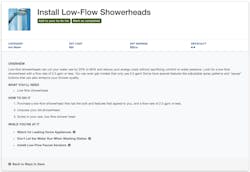Consumer engagement (CE) programs help utilities provide actionable information to their customers based on data collected about their energy and water use. They are an important, and in many ways expected, aspect of doing business today. A valuable tool for deepening the relationship between companies of all kinds and their customers, CE has already gained traction among electric and gas utilities. Water utilities, however, have been slower to embrace their potential.
The greater use of CE programs by energy companies may be tied to complying with regulatory drivers pertaining to the electricity and gas industries, whereas water utilities are not as constrained by such requirements. As an example, many electric utilities have successfully implemented a CE strategy to help reduce peak loads.
Nevertheless, the fact remains that an increasing number of water utilities are establishing CE programs to proactively reach out to customers with information about their water usage. By implementing this approach, these utilities have an opportunity to greatly improve their relationships with customers. According to the J.D. Power 2019 Water Utility Residential Customer Satisfaction Study, for example, “overall [customer] satisfaction scores are 84 points higher when customers recall receiving a proactive communication from their utility (e.g., phone call, e-mail, text message, or social media message) than when customers do not recall a proactive communication.”
What Is Consumer Engagement?
CE solutions enable utilities to provide their customers with personalized and actionable solutions that heighten cost awareness, promote water efficiency, boost utility program enrollment, and increase customer satisfaction scores.
With CE, water utilities can transform the customer relationship from one that is primarily transactional to one that is relational, as CE proactively informs and empowers each customer, which drives trust. CE programs work hand-in-hand with AMI, using data and analytics to enhance billing and make it more transparent. As a result, customers can better understand their bills and usage and take action to manage their consumption and cut costs, alleviating or averting potentially costly problems.
CE programs are typically multi- or omni-channel to provide an integrated, seamless and consistent customer experience. They employ a variety of communication methods to push out personalized messages and notifications pertaining to a customer’s account using that customer’s channel(s) of choice such as online through text messages or e-mail alerts, or through mailers delivered to their home.
Successful CE programs are not only about billing, however, but also about the overall customer relationship with the utility. To further enhance the relationship, for example, some water utilities offer specific utility-sponsored programs or provide useful tips to illuminate ways that their customers can reduce water consumption and ultimately save money. These programs offer ways for customers to create their own “savings plans” and provide practical advice on everything from how to most efficiently wash dishes by hand, to more ways to save water by installing low-flow showerheads or faucet aerators, to a checklist to watching for and fixing (or replacing) leaky home appliances.
Questions to Ask
As with any process, the utility should have a clear understanding of its goals before implementing a CE program. How does CE fit into the company’s long-term objectives? What is the desired outcome? What problem are you trying to solve, or what opportunity do you hope to seize? What metrics will be used to evaluate its success?
From that starting point, the utility should consider these questions in order to evaluate the best fit.
- How easy is the program to implement?
- What are its features and benefits?
- How will you integrate CE with your AMI system?
- How flexible is the solution, or how much customization do you require?
- How secure is the platform?
- What is the cost and anticipated return on investment?
- What success metrics will be used to evaluate the program outcome?
Benefits of Consumer Engagement
CE programs create multiple benefits for customers, who receive information to help them manage their water consumption and lower costs. Empowering them with transparent data as well as information about cost-reducing tools boosts brand loyalty and results in greater customer satisfaction. Customers can also receive information about targeted and relevant utility-sponsored programs, creating further avenues for engagement with the utility.
Utilities also benefit in numerous ways. For example, equipping customers with the tools they need to get information about their accounts enables them to take advantage of resources on the web or via mobile apps. For example, if customers have questions about their bill, they can access that information digitally rather than by calling the utility, freeing up customer service representatives to handle more complex problems and decreasing the cost of serving customers.
On the other hand, if customers are surprised by an unexpectedly large bill in the absence of a CE program, they are far more likely to be angry and dial the inbound call center for answers. Not only does this create dissatisfied customers, it also results in a more expensive — and reactive — way to serve them.
In short, CE enables water utilities to interact with their customers in a way that has become expected in other sectors. By transforming customer relationships beyond the limits of traditional billing, CE creates a win/win for all parties. WW
About the Author
Frank Brooks
Frank Brooks is VP of software product management with Aclara.


